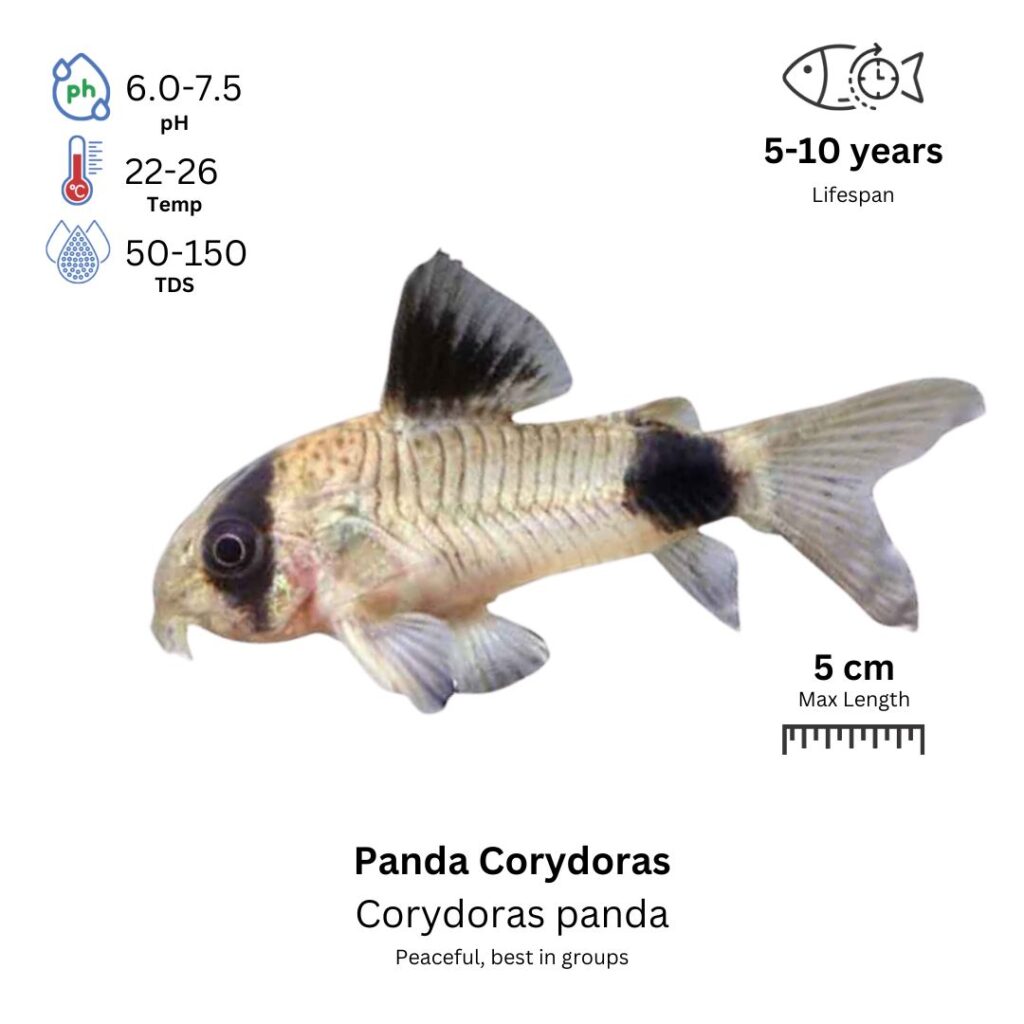Panda Corydoras
Corydoras panda

Description
The Panda Corydoras is a small, peaceful catfish known for its distinctive black markings that resemble the appearance of a panda bear, with a white body and black patches around the eyes and along its back. These fish have a stout, armored body covered with bony plates and whisker-like barbels on their faces, which they use to detect food in the substrate. Panda Corydoras are social and active, often seen scavenging the bottom of the tank for food. They are peaceful and do well in community aquariums, especially in schools of 4 or more.
Habitat Origin
Native to the Rio Ucayali in the Peruvian Amazon Basin, South America, where they inhabit slow-moving waters with a sandy or muddy substrate.
Aquarium
Ideal Number in Aquarium: At least 4-6 individuals for optimal social behavior.
Favorite Food

Panda Corydoras are omnivores and primarily scavengers. They will eat a variety of foods, including sinking pellets, wafers, live or frozen foods like bloodworms, daphnia, and brine shrimp. They are also fond of algae, detritus, and any leftover food from other tankmates.
Behavior:
Panda Corydoras are peaceful, bottom-dwelling fish that prefer to stay near the substrate. They are social and do best in groups of at least 4-6 individuals. These fish are active scavengers and enjoy rummaging through the sand or substrate for food. They can sometimes be seen darting around or interacting with one another in a playful manner, but they are generally calm and non-aggressive.
Special Care:
Panda Corydoras need a tank with a soft substrate, such as fine sand or smooth gravel, to avoid damaging their sensitive barbels. They also appreciate plenty of hiding spots, such as caves, plants, and driftwood. It’s essential to ensure that the water is kept clean and well-filtered, as these fish are sensitive to poor water conditions. Regular water changes are important to maintain their health.
Compatibility with Other Fish:
Yes, Panda Corydoras are ideal for peaceful community tanks. They get along well with other peaceful fish like tetras, rasboras, and small catfish. Due to their peaceful nature, they should not be kept with aggressive or larger species that may harass them. Additionally, as they are bottom-dwellers, it’s important to ensure that other bottom-feeding fish, such as other Corydoras species, are not overcrowding the substrate.
Breeding Tank Setup
A separate breeding tank is highly recommended for Panda Corydoras to ensure clean water and protect the eggs from being eaten. A 10-gallon tank (38 liters) is suitable for a small breeding group, while a 20-gallon tank (75 liters) is better for multiple pairs. Maintain pH 6.0–7.0, temperature 22–28°C (72–82°F), and hardness 2–10 dGH. Use a sponge filter to provide gentle filtration and oxygenation without risking fry being sucked in. Fine sand or smooth gravel should be used as the substrate, with Java moss, Anubias, and small rocks or clay pots to offer egg-laying surfaces. Keep lighting moderate to dim, with a 10–12 hour light/dark cycle.
Conditioning Breeders
To prepare Panda Corydoras for breeding, feed a balanced diet that includes high-quality sinking pellets, live/frozen foods like brine shrimp, daphnia, and bloodworms, and vegetables such as blanched spinach or zucchini. Weekly 20–30% water changes help maintain quality, but to encourage spawning, simulate the rainy season by performing a 50% water change with slightly cooler water, then raising the temperature to around 24–28°C.
Spawning Process
Spawning usually occurs in the early morning following a temperature and water change trigger. Males chase females, who then lay 50–100 sticky eggs on tank surfaces, including plant leaves and glass. Males will fertilize the eggs afterward. Once spawning is complete, remove the adult fish from the tank to prevent them from eating the eggs. Leaving the eggs undisturbed maximizes hatch rates.
Fry Care
Burayak akan tetap diam beberapa hari dan mulai berenang bebas setelah menyerap kuning telur. Beri infusoria atau pakan cair untuk fry selama 3–5 hari pertama, lalu bisa diberikan nauplii artemia. Jaga air tetap bersih dan stabil, lakukan penggantian air kecil dan berkala untuk mendukung pertumbuhan fry. Hindari arus kuat dan cahaya berlebih saat fry masih sangat kecil.
Breeding Maturity, Sexing & Stress Management
Panda Corydoras become sexually mature at 1–2 years. Males are more slender and active, especially during courtship, while females are larger and rounder when gravid. To avoid breeding failure, minimize stress by keeping water parameters stable, performing regular maintenance, and avoiding aggressive or boisterous tank mates. A peaceful and clean environment is key to healthy spawning and fry development.
